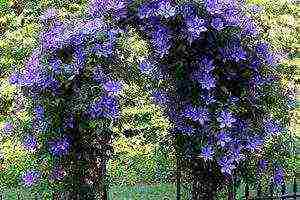Content
- 1 Sweet peas
- 2 Early varieties of peas
- 3 Pea vegetable varieties
- 4 The best varieties of peas for open ground
- 5 Types of seed peas
- 6 The best varieties of peas
- 7 Pea varieties for different regions
Peas are an annual herb that is widespread, both in industrial crops and in household plots. This crop is an excellent predecessor for almost all agricultural crops. The presence of nitrogen-fixing bacteria on the roots allows pea plants to absorb atmospheric nitrogen during the growing season, which has a positive effect on soil fertility. In addition, pea fruit is of great value as a raw material for the food industry. The varieties of this culture differ in many characteristics and have a large assortment. However, on the territory of the Russian Federation, the most widespread varieties are vegetable, sugar and early ripening groups.
Sweet peas
Pea varieties of this group are distinguished by excellent taste. In the process of cultivation, the varieties are unpretentious. Grown products are used with great success in the food industry, fresh and canned. In addition, it should be remembered that the whole sweet shoulder blade is eaten as a whole, since there is no parchment layer in the valves of the beans.
Variety Moscow delicacy
The main characteristics of the variety
- Variety of medium late ripeness group.
- The bush is undersized.
- Plant height 75-85 cm.
- No garter is required.
- The length of the pods is 6-7 cm.
- There are 6-9 peas in the beans.
- The fruit tastes sweet.
- Excellent taste.
- Average resistance to pests and diseases of peas.
- High productivity.
- Recommended for growing on the territory of Ukraine, Moldova and in the conditions of the Central and Central Black Earth regions of the Russian Federation.
Site selection and soil preparation
For growing peas of the Moscow Delicatessen variety, ordinary chernozems are most suitable.You can not sow peas in areas with a close occurrence of groundwater and with insufficient illumination. The best precursors for growing this variety are early cabbage and potatoes. After harvesting the predecessor in the fall, the soil is cultivated by 12-15 cm. In the spring, the soil is leveled with the simultaneous removal of wintering weeds.
Sowing
Before sowing, pea seeds must be re-sorted by removing beans with an unnatural color and odor. Sowing should be done in late March - early April. Early sowing of peas most effectively uses soil moisture and is less damaged by diseases and pests. It is necessary to sow peas in an ordinary way with a row spacing of 15 and 30 cm. About 15-18 seeds should be sown per linear meter. The seeding depth depends on the type of soil. On ordinary chernozems, the depth of planting seeds is 6-8 cm, and on sandy soils, peas should be sown to a depth of 4-6 cm. After sowing, the soil surface must be compacted.
Crop care
Caring for crops of this variety of peas consists of the following activities:
- Loosening the soil. It is carried out as the weeds grow. Perennial weeds with a powerful root system are especially dangerous. The processing depth should be 3-5 cm.
- Irrigation. Watering of vegetating pea plants should be carried out only in the event of a prolonged absence of precipitation. During such periods, it is tedious to water the plants once a week. Watering is best done in the evening.
- Fertilizing plants with mineral fertilizers. For this purpose, nitroammofoska is used at a dose of 15-20 g per 1m2. This fertilizer is evenly scattered over the soil surface and watered with water.
- Disease control. During prolonged rainy weather, the variety can be affected by powdery mildew. When pea plants are affected by this disease, a whitish loose bloom appears on the leaf surface. As a result, the fruits crack and die. Affected leaves and shoots turn black and die over time. To combat the aforementioned disease, the drugs Quadris, Topaz and Topsin are used.
- Pest control. Pea plants can be damaged by the caterpillars of scoops, leaf rollers and moths. To combat them, you can use infusions of tomato tops and garlic.
Harvest
The Moscow delicacy variety is harvested when the peas reach a diameter of 6-8 mm. This period begins approximately 30 days after flowering. The yield of this variety is 1.2 kg / m2.
Children's sugar grade
The main characteristics of the variety
 Early ripening variety.
Early ripening variety.- Plant height 75-80 cm.
- Plants do not need a garter.
- The pods are slightly curved, light green in color.
- The length of the pods is 10-12 cm.
- There is no parchment layer on the peas.
- The variety is moderately resistant to diseases and pests of peas.
- High yield.
- Recommended for growing on the territory of Ukraine, Moldova and in the conditions of the Central and Central Black Earth regions of the Russian Federation.
Soil preparation
The preparation of the soil for sowing the children's sugar peas begins in the fall. First of all, choose a suitable site. Such a site should have a leveled surface with a fertile soil layer. The variety does not withstand wetlands and the presence of a significant amount of weeds. The best predecessors are early potatoes, millet, early cabbage. The aforementioned variety is responsive to deep tillage, so it is advisable to plow the selected area to a depth of 22-25 cm.
Sowing
Sowing the seeds of the aforementioned variety should be carried out in early April. The row spacing is 15 cm. The optimum seeding depth is 5-7 cm. Sowing pea seeds consists of the following measures:
- Removing weeds from the site and leveling the soil.
- Cutting seed furrows, 10-12 cm deep.
- At the bottom of one meter of the sowing furrow, 10 g of ash and 10 g of superphosphate are introduced.
- The applied fertilizers are covered with a layer of earth, 3-4 cm thick.
- Pea seeds are planted at the rate of 16-19 pieces per one meter of the sowing furrow.
- The seeds are covered with loose earth to the level of the soil surface.
Crop care
Pea crop care consists of the following activities:
- Loosening the soil to a depth of 3-5 cm.
- Watering pea plants at the rate of one watering per decade.
- Feeding pea plants with mineral fertilizers. Potassium chloride (10 g / m2) and nitroammofoska (10 g / m2) are best suited for this variety. Fertilizers are scattered over the soil surface and watered with irrigation water to dissolve them.
- Disease control. The variety can be affected by the pea mosaic. This viral disease cannot be cured. Therefore, the best way to protect yourself from it is to maintain a crop rotation.
- Pest control. Pea plants are affected by the larvae of the moth moth. Adults lay eggs on fruits and leaves. After a week, the larvae appear and begin to feed heavily. To combat it, Fastak and Karate Zeon preparations are used.
Harvest
Harvesting of the Detsky Sugar variety is carried out when the peas reach a diameter of 7-8 mm. This period begins approximately 30 days after flowering, in early June. The yield of this variety is 1.1 kg / m2.
Variety Chinese
The main characteristics of the variety
- Mid-season variety.
- The height of the bushes is 65-70 cm.
- The yield is high.
- The length of the pods is 12-14 cm.
- The variety is poorly threshed.
- The resistance to diseases and pests of peas is average.
- High yield.
- Recommended for growing on the territory of Ukraine and in the conditions of the Central and Central Black Earth regions of the Russian Federation.
Soil preparation
The preparation of the soil for sowing Chinese peas begins in the fall. The plot for sowing peas of this variety should have a relatively flat surface and fertile soil. You can not sow pea seeds on clay soils with a close occurrence of groundwater. Areas heavily overgrown with perennial weeds are not suitable. Such weeds will strongly oppress pea seedlings and lead to a significant decrease in the yield of this crop. The best predecessors are cabbage, potatoes, tomatoes, carrots, cucumbers, onions. Tillage is carried out to a depth of 20-25 cm. For this event, both manual tools (shovel, pitchfork) and mechanized tools (walk-behind tractor) are used.In the process of this event, it is necessary to select the roots of perennial weeds from the cultivated land, if necessary.
Sowing
In the spring, the sowing area must be leveled. Sowing seeds of the aforementioned variety should be carried out in early April. The row spacing is 15 cm. The optimum seeding depth is 5-6 cm. Sowing pea seeds consists of the following measures:
- Removing weeds from the site and leveling the soil.
- Cutting seed furrows, 10-12 cm deep.
- 10 g of ash and 10-15 g of superphosphate are applied to the bottom of one meter of the seed furrow.
- The applied fertilizers are covered with a layer of earth, 3-4 cm thick.
- Pea seeds are planted at the rate of 18-20 pieces per one meter of the sowing furrow.
- The seeds are covered with loose earth to the level of the soil surface.
Crop care
Pea crop care consists of the following activities:
- Weed control. It is carried out as soon as weeds emerge. The greatest danger is posed by such weeds as common squid and field mustard.
- Watering pea plants at the rate of one watering per decade.
- Feeding pea plants with mineral fertilizers. Potassium chloride (10-15 g / m2) and nitroammofoska (15 g / m2) are best suited for this variety. The specified volume of fertilizers is dissolved in 10 liters. water and poured into an area of 2 m2.
- Disease control. The variety can be affected by peronosporosis. When pea plants are affected, oval chlorotic spots appear on the leaf surface. A gray-violet bloom forms on the underside of the leaf. To combat this disease, it is necessary to use the fungicide Alto Super.
- Pest control. Pea plants are affected by the larvae of the moth moth.Adults lay eggs on fruits and leaves. After a week, the larvae appear and begin to feed heavily. To combat it, BI-58 and Fastak preparations are used.
Harvest
The Chinese variety is harvested in early July. This period begins approximately 25 days after flowering. The yield of this variety is 1.2 kg / m2.
Early varieties of peas
Early varieties of peas are characterized by a quick ripening of the crop. This allows you to free up the land for planting another vegetable crop. A distinctive feature of early varieties is the ability to withstand spring frosts.
Alpha grade
The main characteristics of the variety
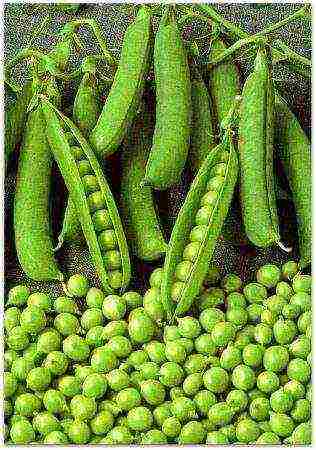 Early ripe variety.
Early ripe variety.- The growing season is 50-55 days.
- The pods are saber-shaped with a sharp tip.
- The length of the pods is 7-10 cm.
- There are 8-10 beans in a pod.
- Pea disease resistance is high.
- Pea pest resistance is average.
- High productivity.
- Recommended for growing in the conditions of Ukraine, Central and Central Black Earth regions of the Russian Federation.
Soil preparation
Plants of the Alpha variety can be strongly oppressed by weeds in the initial period of their development. Therefore, soil cultivation should be aimed primarily at reducing the number of weeds in the selected area. To do this, in the month of August-September, it is necessary to cultivate the soil by 20-25 cm. If in 2-3 weeks weed shoots appear on the soil surface, then the treatment must be repeated. In the spring at the end of March, after the soil has matured, it is necessary to loosen it to the depth of planting seeds in order to destroy early and wintering weeds, as well as to further level the soil surface.
Sowing
Sowing is carried out in early April, and consists of the following stages:
- Removing weeds from the site and leveling the soil.
- Cutting of seed furrows, 10-12 cm deep. The distance between furrows is 15 cm.
- At the bottom of one meter of the sowing furrow, 15 g of nitroammofoska are introduced.
- The applied fertilizers are covered with a layer of earth, 3-4 cm thick.
- Pea seeds are planted at the rate of 17-18 pieces per one meter of the sowing furrow.
- The seeds are covered with loose earth to the level of the soil surface.
Crop care
Pea crop care consists of the following activities:
- Weed control. The greatest danger is posed by such weeds as spurge and sow thistle.
- Watering pea plants at the rate of one watering per decade.
- Feeding pea plants with mineral fertilizers. For this variety, nitroammophoska (15 g / m2) is best suited. The specified volume of fertilizers is dissolved in 10 liters. water and poured into an area of 2 m2.
- Disease control. The variety can be affected by rust. When pea plants are affected, light brown spots are formed on the surface of the leaves and stems. To combat this disease, it is necessary to use the fungicide Alto Super.
- Pest control. Pea plants are affected by the larvae of the pea moth. Adults lay eggs on fruits and leaves. After a week, the larvae appear and begin to intensively feed on young pea pods. To combat it, the drugs Karate Zeon, Fastak are used.
Harvest
The mass harvest of this variety is carried out in mid-July. It should be remembered that the pods ripen unevenly on pea plants. The lower pods ripen first. The yield of this variety is 1.2 kg / m & # 178 ;.
Variety Vegetable miracle
The main characteristics of the variety
Soil preparation
Preparing the soil for sowing peas The vegetable miracle begins immediately after harvesting the predecessor. The best predecessors for this variety are potatoes, cabbage and carrots. Soil cultivation consists in loosening the soil to a depth of 20-25 cm. With the subsequent growth of weeds, loosening the soil must be repeated, but already to a depth of 10-12 cm.
Sowing
Sowing of this variety can be carried out even in the so-called "February windows". Seedlings perfectly tolerate spring frosts, therefore, it is necessary to sow the seeds of the Vegetable Miracle variety as soon as possible.This will allow more efficient use of moisture in the autumn-winter period and less exposure to the negative effects of high temperatures. The method of sowing is an ordinary one with a row spacing of 15 cm. Sowing consists of the following stages:
- Removing weeds from the site and leveling the soil.
- Cutting of seed furrows, 10-12 cm deep. The distance between furrows is 15 cm.
- At the bottom of one meter of the sowing furrow, 15 g of nitroammofoska are introduced.
- The applied fertilizers are covered with a layer of earth, 3-4 cm thick.
- Pea seeds are planted at the rate of 18-20 pieces per one meter of the sowing furrow.
- The seeds are covered with loose earth to the level of the soil surface.
Crop care
Pea crop care consists of the following activities:
- Weed control. Weeds pose the greatest danger to pea plants during the germination period. In the future, pea plants begin to suppress weeds and lead to a complete cessation of their development.
- Watering pea plants at the rate of one watering per decade.
- Feeding pea plants with mineral fertilizers. For this variety, nitroammophoska (15 g / m2) is best suited. The specified volume of fertilizer is dissolved in 10 liters. water and poured into an area of 1.5-2 m2.
- Disease control. The cultivar can be affected by powdery mildew. This disease is especially dangerous in the second half of the growing season of peas. Affected pea plants are covered with a white powdery bloom. To combat this disease, it is necessary to use the fungicide Alto Super.
- Pest control. Pea plants are affected by the larvae of the pea moth. Adults lay eggs on fruits and leaves. After a week, the larvae appear and begin to intensively feed on young pea pods. To combat it, the drugs Karate Zeon, Fastak are used.
Harvest
The mass harvest of this variety is carried out in mid-June. The lower pods ripen first. The yield of this variety is 1.3 kg / m2.
Avola variety
The main characteristics of the variety
- The variety is early maturing.
- The duration of the period from germination to ripening is 55-60 days.
- Plant height 65-70 cm.
- The length of the beans is 6-9 cm.
- The number of beans in a pod is 7-8.
- The variety is resistant to fusarium wilt.
- The resistance of the variety to pea pests is average.
- High productivity.
- Recommended for growing in the conditions of Ukraine, Central and Central Black Earth regions of the Russian Federation.
Soil preparation
For sowing peas, you need to choose areas with fertile soil and deep groundwater. The best soil for growing peas is ordinary chernozem. Tillage should be carried out to a depth of 15-20 cm in the autumn. In the spring, before sowing peas, it is necessary to loosen the soil to a depth of 8-10 cm.
Sowing
Sowing of the seeds of the aforementioned variety should be carried out in the first decade of April. The row spacing should be 15 cm. The seeding depth is 5-6 cm. Sowing pea seeds consists of the following steps:
- Removing weeds from the site and leveling the soil.
- Preparation of seed furrows, 10-12 cm deep.
- 10 g of ash and 10-15 g of nitroammofoska are added to the bottom of one meter of the sowing furrow.
- The applied fertilizers are covered with a layer of earth, 3-4 cm thick.
- Pea seeds are planted at the rate of 18-19 pieces per one meter of the sowing furrow.
- The seeds are covered with loose soil and compacted.
Crop care
In the process of growth and development of pea plants, it is necessary to carry out the following activities:
- Weed control. Carried out as weeds emerge. The greatest danger is posed by such weeds as common squid and field mustard.
- Watering the pea plants. Carried out at least once a week.
- Feeding pea plants with mineral fertilizers. For this variety, in the process of feeding, it is necessary to add nitroammophoska at a dose of 10-15 g / m2. The specified volume of fertilizers is dissolved in 10 liters. water and irrigate an area of 1 m2.
- Disease control. The cultivar can be affected by powdery mildew.When pea plants are affected, a white powdery bloom appears on the leaf surface. To combat this disease, the fungicide Alto Super is used.
- Pest control. Pea plants are affected by the root weevil. These pests are most dangerous in early spring, as they damage the cotyledons and the growing point on pea seedlings. To combat it, the drugs BI-58, Sumi-alpha, Fastak are used.
Harvest
The variety is harvested during the months of June and July. Ripening occurs in waves and stretches over time. The yield of this variety is 1.3 kg / m2.
Pea vegetable varieties
The fruits of vegetable varieties of peas are characterized by the maximum amount of sugars. They have the sweetest and most pleasant taste. Peas are round and wrinkled. The last variety is also called "brain pea".
Vera variety
The main characteristics of the variety
- The variety is early maturing.
- The period from germination to technical ripeness is 50-55 days.
- Plant height 55-65 cm.
- The pods are straight and slightly curved.
- The length of the pods is 6-9 cm.
- There are 6-9 beans in a pod.
- The beans are covered with a parchment layer.
- Pea disease resistance is average.
- The resistance to damage by the moth is high.
- Average yield.
- Recommended for cultivation in the Central Black Earth Region of the Russian Federation.
Soil preparation
For this variety, the most suitable soils are medium loamy, moisture-consuming, rich in humus. Based on this, ordinary chernozems are the most optimal soils for growing peas of the Vera variety. On poor soils, peas will give low yields. On sandy soils, peas ripen 5-7 days ahead of schedule. In vegetable crop rotations, good predecessors of peas are: pumpkin, cucumber, cabbage, tomato, potatoes. Tillage begins immediately after harvesting the predecessor, and consists of the following activities:
- loosening the soil after harvesting the predecessor to a depth of 3-5 cm;
- autumn plowing to a depth of 20-25 cm;
- spring loosening to a depth of 5-7 cm;
- leveling the soil;
- pre-sowing treatment of the soil to the depth of seeding.
Sowing
The Vera variety must be sown early. A delay in sowing leads to a yield decrease of up to 50% or more. Peas are sown at the end of March. Sowing of peas is carried out in a row method with row spacing of 11.7 cm, 15 and 20 cm.On 1 m2 there should be from 80 to 130 plants. Pea seeds are sown to a depth of 4-6 cm. Simultaneously with sowing, 15 g of nitroammophoska are added per 1 m of the sowing line.
Crop care
- Loosening the soil. It is carried out in the phase of emergence to a depth of 3-5 cm.
- Watering. Held once a week.
- Top dressing with mineral fertilizers. With pouring water, 10 g / m2 of ammonium nitrate and 15 g / m2 of ammonium sulfate should be added. Such feeding is carried out three times in the initial period of development of plants of this variety.
- Disease control. The variety can be affected by Fusarium. Fusarium is a disease that affects not only seedlings, but also adult plants. Seedlings wither, and adult plants are depressed. To combat fusarium, it is necessary to observe the correct crop rotation, destroy plant residues and sow healthy seeds.
- Pest control. Plants of the Vera variety can be affected by the nodule weevil. This pest is most dangerous in early spring. They damage the cotyledons and the growing point on pea seedlings. To combat it, the drugs Sumi-alpha and Fastak are used.
Harvest
The variety is harvested throughout the months of June and July. Ripening occurs in waves and stretches over time. The yield of this variety is 1.0 kg / m2.
Salute variety
The main characteristics of the variety
- The variety is early maturing.
- Plant height ranges from 60 to 85 cm.
- Plants do not require a garter.
- The length of the pods is 7-9 cm.
- One pod contains 7-8 beans.
- Resistant to viral infections.
- Medium resistant to the main pests of peas.
- High productivity.
- Adapted to growing in the Central and Central Black Earth regions of the Russian Federation.
Soil preparation
For the Salut variety, ordinary chernozems are most suitable. On poor soils, peas will give low yields. Good predecessors of peas are: pumpkin, cucumber, cabbage, tomato, potatoes. Tillage begins immediately after harvesting the predecessor, and consists of the following activities:
- loosening the soil after harvesting the predecessor to a depth of 3-5 cm;
- autumn plowing to a depth of 20-25 cm;
- spring loosening to a depth of 5-7 cm;
- leveling the soil;
- pre-sowing treatment of the soil to the depth of seeding.
Sowing
The Salute variety must be sown early. Peas are sown in the third decade of March. Sowing of peas is carried out in a row method with row spacing of 15 and 20 cm. 16-18 seeds should be located on 1 meter of the sowing line. The seeding depth is 5-7 cm. Simultaneously with sowing, 15 g of nitroammophoska are applied per 1 m on the sowing line.
Crop care
- Loosening the soil. It is carried out, if necessary, in the phase of emergence to a depth of 3-5 cm. In the process of further development, pea plants easily drown out the growth of weeds.
- Watering. Held once a week.
- Top dressing with mineral fertilizers. With pouring water, 10 g / m2 of ammonium nitrate and 15 g / m2 of ammonium sulfate should be added. Such feeding is carried out three times in the initial period of development of plants of this variety.
- Disease control. The cultivar can be affected by powdery mildew. Affected pea plants are covered with a white powdery bloom. To combat this disease, it is necessary to use the fungicide Alto Super.
- Pest control. Pea plants are affected by the larvae of the pea moth. Adults lay eggs on fruits and leaves. After a week, the larvae appear and begin to intensively feed on young pea pods. To combat it, the drugs Karate Zeon and Fastak are used.
Harvest
The variety is harvested throughout the months of June and July. Ripening occurs in waves and stretches over time. The yield of this variety is 1.3 kg / m2.
Premium grade
The main characteristics of the variety
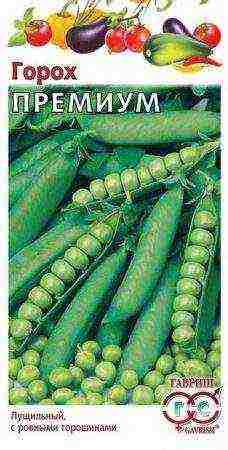 Mid-season variety.
Mid-season variety.- The first fruits ripen 55 days after germination.
- Plant height 75-80 cm.
- There are 8-9 beans in a pod.
- Fruit ripening is amicable.
- Plants need tying.
- Resistant to major diseases of peas.
- Resistance to the main pests of peas is average.
- High-yielding variety.
- Recommended for cultivation on the territory of Ukraine, Moldova and in the conditions of the Central and Central Black Earth regions of the Russian Federation.
Soil preparation
Preparing the soil for sowing the Premium variety begins in the fall. First of all, choose a suitable site. Such a site should have a leveled surface with a fertile soil layer and low weed infestation. The variety does not withstand wetlands. The best precursors are early potatoes and early cabbage. In the fall, it is advisable to plow the selected area to a depth of 22-25 cm.In the spring, the soil is loosened to a depth of 5-7 cm.
Sowing
Sowing the seeds of the aforementioned variety should be carried out at the end of March. The row spacing is 15 cm. The optimum seeding depth is 5-7 cm. Sowing of pea seeds consists of the following measures:
- Removing weeds from the site and leveling the soil.
- Cutting seed furrows, 10-12 cm deep.
- 10 g of superphosphate is added to the bottom of the seed furrow.
- The applied fertilizers are covered with a layer of earth, 3-4 cm thick.
- Pea seeds are planted at the rate of 16-19 pieces per one meter of the sowing furrow.
- The seeds are covered with loose earth to the level of the soil surface.
Crop care
Pea crop care consists of the following activities:
- Loosening the soil to a depth of 3-5 cm, a week after the emergence of the soil.
- Watering pea plants at the rate of one watering per week.
- Feeding pea plants with mineral fertilizers.Potassium chloride (10 g / m2) and nitroammofoska (10 g / m2) are best suited for this variety. Fertilizers are scattered over the soil surface and watered with irrigation water to dissolve them.
- Garter plants.
- Disease control. The variety can be affected by the mosaic of peas. This viral disease cannot be cured. Therefore, the best way to protect yourself from it is to maintain a crop rotation.
- Pest control. Pea plants are affected by nodule weevils. These pests eat up the leaves, and the larvae damage the root system of pea plants. To combat it, the drugs Arrivo and Stefesin are used.
Harvest
The variety is harvested when the peas reach a diameter of 7-8 mm. This period begins approximately 30 days after flowering, in early June. The yield of this variety is 1.2 kg / m2.
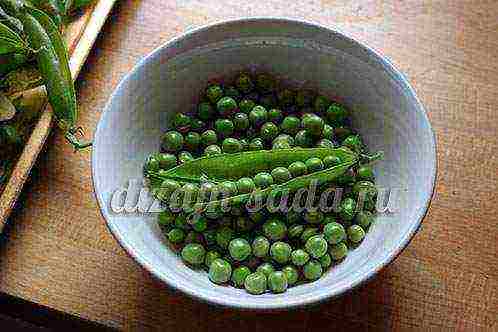
Often novice gardeners ask which varieties of peas are the best. Everyone wants to grow fruitful, tasty, sweet peas.
Peas differ not only in taste, but also in plant height and ripening times. So, if you plant several varieties of peas with different ripening periods in early spring, then you can feast on this delicious vegetable for as much as two to three months. The main thing is to choose the right varieties.
Sugar peas are delicious and can be eaten with the shutters, as coarse fibers do not form in them. Brain peas (shelling) are also very tasty, but they are mainly used for freezing and canning. Shell peas also have smooth-grain varieties, we usually buy them in the store by weight, for making soup and cereals.
Consider the best varieties of green peas, which are such according to numerous reviews of gardeners. These varieties have both taste and yield at the proper height.
Pea varieties: photo, description, reviews
Currently, 79 varieties of peas are included in the State Register of Breeding Achievements of the Russian Federation, admitted for use.
Peas Alpha
Early maturing (the period from full sprouting to ripeness is 46-53 days), a fruitful variety of peas. This variety is characterized by a friendly return of the harvest.
Plant 50-55 cm high. Pods are dark green, slightly curved with a pointed tip, 7-9 cm long. Each pod contains dark green, even in color and size, sweet peas with excellent taste.
These green peas are great for fresh consumption, home cooking, canning and freezing.
Alpha pea yield: up to 2.8 kg / m² of pods.
Seeds are planted in rows, every 5 - 6 cm, with row spacing of 15 - 20 cm.
Shell peas Alpha recommended for cultivation in the Altai Territory, Kamchatka Region, in the Non-Black Earth Zone, the Central Black Earth Region, in the North Caucasus zone, in the Ukraine, in Belarus, and in Moldova.
Peas Ambrosia
An early ripening variety of sugar peas. It takes 54-56 days from germination to technical ripeness of beans.
Plant height 60-70 cm, so supports or trellises are required. In the early stages, peas are used for food along with the valves.
The pods are light green, up to 10 cm long, contains 8-9 grains, there is no parchment layer in the valves. The peas themselves are fleshy, tender, juicy. These green peas are good for fresh consumption, freezing and canning.
Productivity of ragweed peas: 0.9 - 1.3 kg.
Agrotechnics of peas: sowing in open ground at the end of April - beginning of May to a depth of 3-4 cm according to the scheme of 30 x 15 cm.
Peas Vera
An early variety of hulling peas for fresh use and processing (50 days pass from the moment of germination to technical ripeness).
Bred by VNIISSOK, zoned for the North Caucasian and Middle Volga regions. Plant height 55-65 cm, pods are straight or slightly curved, 6-9 cm long, with 6-9 peas and a strong parchment layer. The flowers are white.
Productivity of Vera peas: 0.7-1.2 kg per 1 sq. m.
Advantages of the variety: good yield, amicable ripening, resistance to damage by the moth.
Pea Zhegalova 112
A mid-season high-yielding variety of sugar peas, 50-60 days pass from germination to technical ripeness. The Zhegalova 112 variety was bred at the Gribovskaya vegetable selection station.
Plant height 120-180 cm, needs support. The pods are straight or slightly curved, 10-15 cm long, with a blunt apex, with 5-7 peas. The pea blades are thick, fleshy, nutritious and delicious.
The pod harvest period lasts 15-20 days. The taste of green peas is very delicate and sweet.
Productivity of peas Zhegalov 112 - up to 1.2 kg from 1 sq. m.
Pea seeds from Gavrish.
Peas Sugar Oregon
A mid-early variety of sugar peas, 55 days pass from germination to ripeness.
Plant height 70-100 cm, supports required. The pods are 10 cm long, with 5-7 smooth peas, wide, without a hard parchment layer.
Not only peas are used for food, but also the shoulder blades themselves. The variety is suitable for canning.
Seed producer: Plasma Seeds firm.
Pea Oscar
Mid-season (65 - 70 days from germination to maturation) sugar pea variety. An analogue of the Tristar variety, but with an earlier ripening period, more tender and sweet peas.
The plant is 70-80 cm high. The first inflorescence is formed above 7-8 leaves, with 2-3 blades in each. The peas are large, with a diameter of 8 to 10 mm. The pods are curved with a sharp top, medium length, wide, green. Each pod contains 10-12 peas. In the early stages of development, the parchment layer is absent.
These peas are used fresh, for freezing and canning.
The variety is highly resistant to disease.
Sowing peas in open ground at the end of April - beginning of May to a depth of 3-4 cm (if you sow smaller, birds can peck out the grains) according to the scheme 30 x 15 cm.
Oscar pea yield: 0.5 - 0.9 kg from 1 sq.m.
Children's sugar peas
An early ripe high-yielding sugar variety of peas.
Plant with a height of about 80 cm, can be grown without supports. Pods are light green, slightly curved, 10-11 cm long, wide, without parchment layer.
Children's sugar pea variety is used for fresh consumption, canning and freezing.
Peas yield Baby sugar - up to 1.5 kg from 1 sq. m.
Seed producer: Aelita firm.
Peas Moscow delicacy
A mid-season variety of green peas, is rightfully considered the sweetest. The excellent delicious taste of this high-yielding early variety will be a discovery for you.
Peas Moscow delicacy is suitable for fresh consumption, as well as for canning and freezing.
Pea seeds Moscow delicacy is produced by the company “Russian garden”.
Peas Miracle of Kelvedon
An early ripe high-yielding sugar variety, 60-75 days pass from germination to ripeness.
The plant is slightly branched, 45-55 cm high. The pods are 6-8 cm long, with 7-8 large, dark green sweet peas.
Advantages of the variety: cold resistance, lodging resistance, high taste and dietary qualities, increased protein content.
Pea yield Miracle of Kelvedon: 0.8 - 1.2 kg from 1 sq.m.
Agrotechnology: to obtain a harvest of peas throughout the summer, the seeds are sown in 2-3 terms with an interval of 10-15 days. The Kelvedon Miracle pea variety is suitable for fresh consumption, as well as for canning and freezing.
Pea slider sugar
An early ripening variety of leafless peas (period from germination to technical ripeness of 53-55 days), characterized by one of the longest fruiting periods among the early varieties.
The plant is 70-75 cm high, grown unsupported and does not lie down. Pods are light green, slightly curved, narrow and long (up to 10 cm). Each pod contains 8-9 sweet and tasty peas.
These green peas are great for fresh use, canning and freezing.
Advantages of the variety: long fruiting period, does not require supports, early maturity.
We recommend purchasing high-quality peas for planting in the Sady Rossii online store.
What kind of peas do you plant? Which peas are the sweetest? And the most productive?
Your reviews and additions will help many gardeners choose the sweetest, most fruitful, delicious, delicate varieties of peas for planting. If possible, attach a photo of the peas you have grown.
Do not forget to indicate your city or region, so we will help readers choose pea varieties, for example, for the Moscow region, the north-west, for the Urals and Siberia, the Leningrad region, for the northern regions and the middle zone. That is, separately for each climatic zone. Thanks for the feedback!
Both adults and children love to eat green peas. Practically in every vegetable garden there is a place for vegetable legumes, moreover, agricultural technology does not include complex measures. An important component of a good harvest is the selection of a variety and high-quality pea seeds. With the current assortment of seed, making a choice is not so easy, a description of the different varieties will help you with this.
The best varieties of peas for open ground
In this article, you can familiarize yourself with the most popular varieties, the yield and quality of the fruits of which have been tested for years.
Peas Alpha
The ripening period of the Alpha variety is early, from the moment of germination of shoots above the soil surface to technical ripeness, 45-55 days pass. The variety has a stable yield (6-7 t / ha), resistance to fusarium, ascochitosis and other diseases.
The height of the bush in centimeters reaches 55, 2 beans are formed in each bosom, 5-9 seeds develop in a pod 7-9 in length.
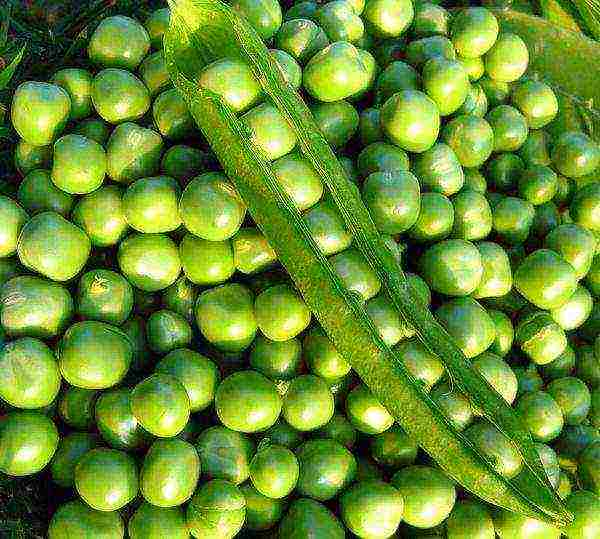 Pea variety Alpha
Pea variety Alpha
The peculiarity of the culture lies in the high market value and taste due to the high sugar content in the composition.
When sowing, the scheme is used: row spacing - 20, the interval between seeds - 5, the depth of immersion of the peas - 3-4.
Sugar grade
Early ripening peas with a growing season of 55-60 days. The height of the bush reaches 50-70 cm, and therefore requires a garter. Pod parameters at the stage of technical ripeness: length - 7-8 cm, number of seeds - 5-9 pieces. The culture is resistant to ascochitosis and powdery mildew.
With proper fertilization of the soil at the stage of preparation for sowing, no further feeding is needed. Features of the fruit - very sweet taste, ideal for canning. Yield indicators: 7-8 t / ha.
 sugar peas
sugar peas
Ambrosia
A high-yielding variety with a maturation period of 45-56 days. The bush is formed to a height of 70 cm, so a garter or installation of trellises is required. In the axil of the plant, 2 beans each develop. At the stage of technical ripeness, the pod length reaches 8-10 cm, each contains 6-8 seeds... Disease resistance is average, tolerance to fusarium is noted.
Sowing work is carried out in May, and in June it is time to harvest (up to 1.3 kg per 1 m2). When planting, the scheme is used: 30x15, the immersion depth of the peas is up to 5-6 cm.
Regular application of mineral fertilizers prolongs the fruiting period, which increases the yield.
faith
A super early pea variety with a growing season of 50 days. The bush is formed of medium size, reaching a height of half a meter. Straight or slightly curved pods contain 6-9 peas. Amicable germination of crops is replaced by no less amicable fruiting.
Intense maturation requires additional nutrients that need to be added in the form of top dressing every 10 days. Harvest up to 500 grams per square meter. When disembarking, the scheme is used: 15x5, immersion depth - 4-6. The beans are used fresh, for freezing and canning.
Oscar
A high-yielding early-ripening variety with a growing season of 65-69 days. Bushes are formed high, reaching 80 cm, so trellis should be installed along the bed or tie to individual pegs.The pod is large, dark green in color, up to 9 cm long, contains 10-12 seeds. Average disease resistance, the plant is tolerant to fusarium wilt... Yield indicators: 7 t / ha.
When planting, the scheme is used: 20x6 cm.If high-quality soil fertilization was carried out before sowing, then fertilizing can be omitted.
Baby sugar
An unpretentious high-yielding variety with a growing season of 60-70 days. A strong stem is formed up to 80 cm in height, which provides for the procedure of tying or installing a trellis. On one bush, an average of 14 pods are tied, each reaching 5-8 cm in length, the number of peas is 6-9 pieces.
The peculiarity of the plant is the absence of a parchment layer, which allows you to use the fruits fresh without extracting from the pods.
Also, the beans are suitable for freezing and canning.
The culture has an average resistance to diseases, withstands night spring frosts, therefore it is suitable for growing in Siberia. Agrotechnics are very simple, there are no special conditions for watering and feeding.
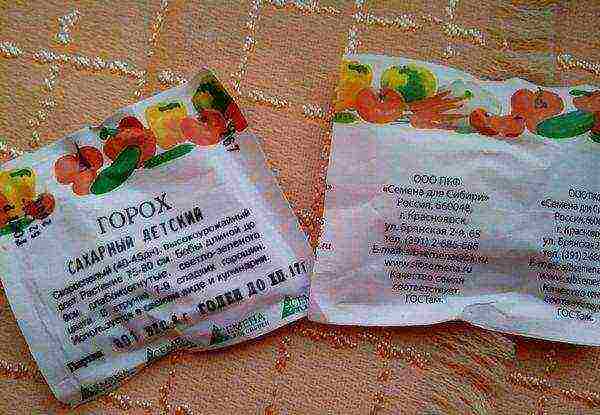 Pea seeds baby sugar
Pea seeds baby sugar
Sugar Oregon
A medium-early ripening culture with a vegetation period of 55-70 days. Peas are considered one of the best for growing in the Moscow region. The height of the bush sometimes exceeds the 1 m mark, so trellises must be installed along the beds. The average length of the beans is 7-9 cm, each containing about 7 peas with a smooth surface. The peculiarity of Sugar Oregon is the thickness of the parchment layer, it is so thin that it can be eaten with the pod.
When disembarking, use the scheme: 30x15. Young shoots develop intensively in fertile soil rich in calcium (the medium should be neutral or slightly acidic). Aeration also affects yield, so it is carried out regularly.
Pharaoh
The culture is mid-season with a growing season of 68-85 days. The peculiarity lies in the high yield, about 18, 9 centners are removed from one hectare. The plant has good immunity, easily tolerates drought. Tolerance to root rot and ascochitosis is noted. The number of nodes up to the first inflorescence is 11-15, 3 flowers are formed on each.
Salute
Ripening period - early, growing season lasts days. The bushes have a powerful stem, therefore, at a height of 65-80 cm, a garter is not a must. Ripe pods reach a length of 8-9 cm, each containing 7-8 peas. Brain variety is distinguished by high commercial characteristics and taste.
Troika
Late ripening plant with a vegetation period of 78-96 days. The bushes are of medium length, so a garter must be made.
Small peas in a bean are formed by small 6-7 pieces, but very sweet, for which they are appreciated by farmers and cooks.
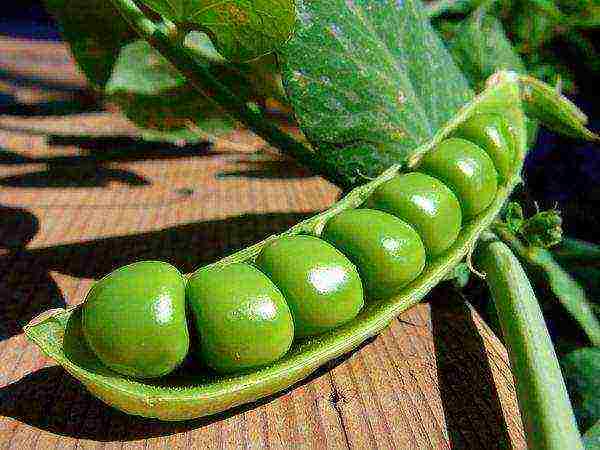 Peas Three
Peas Three
Yield indicators - 5 t / ha. The top three belongs to the brain varieties, the taste, as well as the marketable ones, are at their best.
Even a novice gardener can cope with growing peas in the open field. As a reward for the time and effort spent, you can get a nutritious and vitamin-rich product that will complement the delicate taste of many dishes.
Peas are one of the most popular agricultural crops. It is grown both by large agricultural enterprises and ordinary amateur gardeners. The range of applications for peas is also very wide. Unripe seeds are eaten fresh and used to prepare various dishes, including the beloved Olivier salad, and mature seeds are most often used for soups and cereals. In addition, peas, like other legumes, are capable of enriching the soil with nitrogen, making them an ideal precursor for most agricultural plants.
Types of seed peas
Sowing peas are a species of the genus Peas of the legume family. It is an annual climbing plant that has been cultivated by humans since ancient times. Paleobotanists claim that dried peas were found in buildings from the Stone and Bronze Ages.
In the Middle Ages, peas were one of the main food products of mankind. At that time, people only used its fully ripe seeds, from which they made porridge and soups. Green peas began to be eaten only in the 17th century. He received the greatest distribution in France and Great Britain. The invention of conservation and freezing played a significant role in the popularization of unripe peas. Thanks to these methods of preparing food, we got the opportunity to eat them all year round, and not just in the summer.
Video: nutritionist about the benefits of peas
Today, there are three main varieties of sowing peas:
- shelling (Pisum sativum convar. sativum) - these are peas with spherical smooth seeds and a high content of parchment in the pod. When ripe, its peas contain a large amount of starch and are eaten only after boiling or stewing. They are also used in the chemical industry for the production of bioplastics. Unripe pea seeds are eaten fresh, but they quickly overripe and become mealy;
- cerebral (Pisum sativum convar. medullare) - its distinguishing feature is the high (6–9%) sugar content in peas that shrivel after ripening. At the stage of technical ripeness, they have excellent taste and are often used for conservation and freezing. Ripe seeds of brain varieties are unsuitable for making soups and cereals, as they retain their hardness even after prolonged heat treatment;
- sugar (Pisum sativum convar.axiphium) - it is characterized by small, rounded peas and a soft, juicy pod, practically free of parchment. Whole beans with underdeveloped seeds are eaten.
Photo gallery: variety of cultivars of sowing peas
The best varieties of peas
Today there are many varieties of peas that differ from each other not only in the type of fruit, but also in the ripening period, the size of the bush and other characteristics. From this variety, each gardener can choose the crop that is most suitable for his site.
For open ground
Peas do not need a lot of heat, so they are most often grown outdoors. Almost all varieties are suitable for this, but high-yielding and unpretentious representatives, not prone to lodging and shedding seeds, are in maximum demand. These qualities are especially important in industrial cultivation.
Leafless pea varieties are great for outdoor planting. Due to the large number of antennae replacing the leaves, the plants adhere tightly to each other and do not need to install supports, which greatly simplifies their care and saves the gardener's efforts.
Table: varieties of peas for open ground
Photo gallery: some varieties of peas for open ground
Undersized
Pea varieties are called stunted, the stem height of which does not exceed 70 cm. They are very popular with gardeners, so they do not require tying and they tolerate the vagaries of the weather well. These varieties include:
- Alpha,
- Early Gribovsky,
- Shustrik,
- Miracle of Kelvidon (Kelvedon Vonther),
- Watan,
- Faith,
- Ambrosia.
Let's consider the most popular ones.
Alpha
An early ripe variety of shell peas. The height of its stem does not exceed 55 cm. The internodes are short, the first pods are attached at a height of 9–11 knots.
Alpha's dark green pods range in length from 7 to 9 cm and width from 1.2 to 1.4 cm. Each of them contains 5-9 squashed peas, even in size and color. They are used both fresh and for canning.
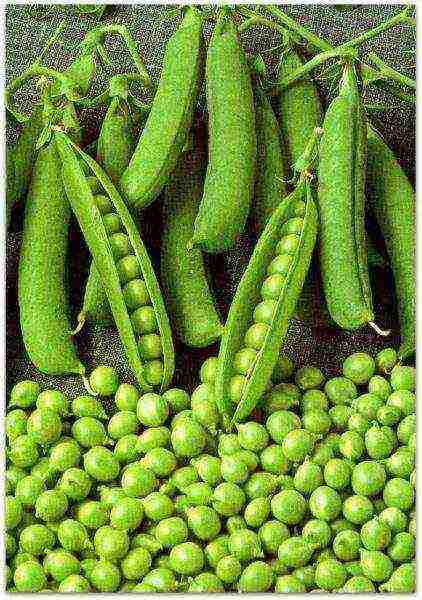
One Alpha bean contains 5 to 9 peas
From one hectare of Alfa's plantings, 4.8 to 9 tons of green peas are harvested, which have an excellent taste. The variety has a relative resistance to ascochitosis and fusarium and reaches technical ripeness 46-53 days after germination. Recommended for cultivation in all regions of Russia, except for Volgo-Vyatka, Ural and North.
This year I liked Alpha peas. Kustovoy. Height 40 centimeters, stood together as a wall, clinging antennae and supporting each other. I planted it in July, put it in the freezer in the fall.
Ambrosia
One of the most popular sugar peas in our country, included in the State Register as recommended for cultivation in personal subsidiary plots in all regions. Its stem is 50 to 70 cm long, and the attachment height of the lower pods is about 35 cm.
Ambrosia beans are large, slightly curved, light green at the stage of technical ripeness. Medium peas, when fully ripe, acquire a yellowish color and wrinkled structure.

Ambrosia beans have a great, delicate flavor
The yield of unripe Ambrosia beans is 500-600 g per 1 sq. m. They are eaten whole fresh or after short-term culinary processing.
Ambrosia from "Gavrish" - planted in the summer of the 13th, very tender and tasty, I don't even know which is tastier, the pods or the peas themselves. Forms 8-9 beans per pod, 25 percent - 7 peas.
I planted it on May 3, out of 20 sprouted 12. By July 10, I removed more than 100 pods. Low, 50–70 cm. I recommend.
Tall
The stems of tall varieties of peas can reach a height of 2 m. They require the mandatory installation of supports and are very demanding on growing conditions. But the difficulty of cultivating them is more than offset by a bountiful harvest of high quality beans. Tall pea varieties include:
- Telephone,
- Giant,
- Miracle spatula,
- Zhegalova 112,
- Sugar snap.
The most popular varieties are Telephone, Sugar Snap, Zhegalova 112.
Telephone
High-yielding late ripening variety. From sowing to the beginning of harvesting the pods, it takes 100-110 days. Moreover, ripening is of an extended nature: first, the beans located in the lower part of the plant ripen, and after a while - in the upper part. With the timely harvesting of ripe peas and a sufficient amount of moisture, the formation of new pods is possible.

With timely harvesting of ripe pods and a sufficient amount of watering, peas of the Telephone variety form new pods
Depending on the growing conditions, the height of the stem of the Telephone variety ranges from 150 to 200 cm, and according to some sources - up to 300 cm. The length of the bean is about 11 cm. The peas are large, round, with an excellent sweetish taste.
The telephone has overshadowed all possible varieties. Tall, hung with pods, excellent taste, suitable for canning.
Zhegalova 112
A medium late variety of sugar peas. Its technical ripeness occurs in 50-60 days after germination, and biological - in 90-110 days. The average yield is 14.4 centners of unripe beans per hectare.
Peas Zhegalov 112 was approved by the State Sort Commission for use throughout the country, with the exception of the Lower Volga, East Siberian and Far Eastern regions back in 1943.
Variety Zhegalova 112 is a plant with a climbing stem 120-180 cm high. At the stage of technical ripeness, the beans are xiphoid, light green, their length can reach 15 cm, and their width is 2.5 cm. One bean contains from 5 to 8 rounded - angular peas.

The blades of the Zhegalova 112 variety are very large and tasty
Unripe pods of Zhegalov 112 peas have a good taste. They are consumed fresh and used to prepare various dishes.
A masterpiece to taste is Zhegalov's variety. Growth up to 2 meters. Sweet. Harvestable. The shoulder blades are 15 cm and 2 cm wide. In general, a favorite.
Sugar snap
American selection of sugar peas. Under favorable growing conditions, its stems reach a height of 1.5–2 m.
Pea beans of the Sugar Snap variety are convex, short, do not contain a parchment layer and do not lose their taste for a long time. The peas are round, medium in size. Unripe pea pods of this variety are eaten fresh, and after they are fully ripe, stews and soups are prepared from them.
Video: personal experience of growing peas Sugar snap
Brain
Brain peas are ideal for canning or freezing for the winter. They have an excellent sweet taste and a high content of substances beneficial to humans. On personal plots and on farms in Russia and the CIS countries, the following varieties of this type of peas are most often found:
- Adagumsky,
- Honey cake,
- Golden eagle,
- Prelado,
- Dinga,
- Premium,
- Tropar.
Most often sown varieties Adagumsky, Prelado, Tropar.
Adagumsky
A time-tested variety of cereal peas with an average ripening period (68–74 days from the moment of germination). It was bred back in 1975 at the Experimental Station in the city of Krymsk, and in 1980 the State Commission for the Protection and Research of Breeding Achievements allowed it to be used throughout Russia, except for the Northern, Lower Volga, West Siberian and Far Eastern regions. For more than 40 years of its existence, Adagumsky has not lost its popularity due to such qualities as:
- high yield (up to 9.6 t / ha);
- relative resistance to powdery mildew and ascochitosis;
- friendly return of fruits;
- suitability for mechanized harvesting.
Pea varieties Adagumsky is a plant with a height of 70–80 cm with well-developed tendrils. The beans are straight, with a sharp top. Their length can reach 7 cm. On one bush, 8 to 14 beans are formed, containing 6–9 medium-sized peas, at the stage of technical ripeness colored in a dark green color and having an excellent taste both fresh and processed.

Adagumsky is the oldest variety of Russian cereal peas
Prelado
Early maturing (45-50 days), amicably maturing variety of Dutch selection, zoned for the North Caucasus region. It is characterized by a stem of medium height with blue-green leaves covered with a waxy coating. The height of attachment of the lower pods is 32–37 cm.
Prelado beans are short, of medium width. Sized peas have a dark green color and good taste in technical ripeness. Once fully ripe, they become wrinkled while retaining their green color.
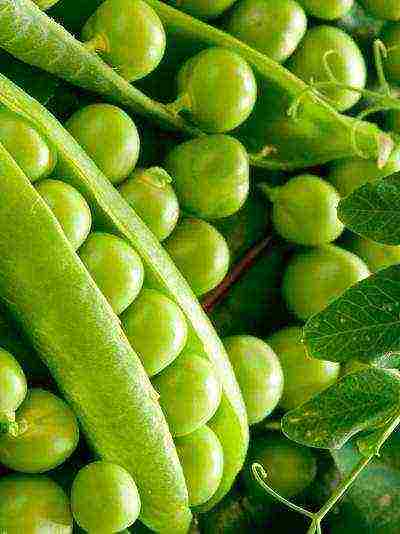
Some gardeners say that there are exactly 7 pots in each Prelado pod.
Among the main advantages of this variety, gardeners note:
- good yield (26–89 kg / ha);
- resistance to fusarium and yellow bean mosaic virus;
- lack of inclination to lodging;
- convenience of mechanized harvesting.
Tropar
Tropar is a low-growing variety of cereal peas. The length of its stem does not exceed 45-50 cm. The lower beans are formed at a height of 20-25 cm.
The straight, blunt-topped Tropar beans contain 6–7 light green, angular peas that taste good. They are used for eating fresh and for preservation.
Depending on the growing conditions, the average yield of Tropar ranges from 2.3 to 5.5 t / ha. It is moderately resistant to ascochitosis and root rot caused by Fusarium, but often suffers from tuberous weevils and moths.
Early
Early varieties of peas are ready for harvesting as early as 32–55 days after germination. They can be sown several times a season and get 2-3 harvests of sweet and tasty peas.
Table: the earliest ripening pea varieties
Photo gallery: some early ripening peas
Pea varieties for different regions
Peas are a very unpretentious plant that feels well almost throughout Russia and other CIS countries. Nevertheless, for planting on your site, it is better to choose zoned varieties that are most adapted to the climate of a particular region.
For Siberia
Despite the rather difficult climatic conditions of the region, peas in Siberia grow very well and bear fruit. Here are common varieties such as:
- Altai emerald,
- Annushka,
- Varangian,
- Darunok,
- Demos,
- Zavodoukovsky,
- Pearl,
- Narymsky 11,
- Russia,
- Svetozar,
- Yakhont.
The low-growing variety of brain peas Altai Emerald, which has a high yield (80-109 c / ha), is in special demand among gardeners in Western and Eastern Siberia. Its large, dark green peas contain a large amount of dry matter (20.3-23.7%) and sugars (5.5-6.2%). In addition, they have excellent taste and are perfect both for fresh consumption and for preservation.

Pea variety Altai emerald has a high yield (80-109 c / ha)
For central Russia and the Moscow region
In central Russia and the Moscow region, peas have been grown for more than one hundred years. Before the start of potato cultivation, it was the main agricultural crop in this region. Today, many varieties of peas are zoned here, including:
- Afonka,
- Farm laborer,
- Burgomaster,
- Gloriosa,
- Jackpot,
- Children's joy
- Znayka,
- Calypso,
- Lincoln,
- Nemchimovsky 100,
- Spartacus,
- Triumph,
- Round dance,
- Anniversary.
Gloriosa is a popular mid-season cereal pea variety. It is a plant of medium height with long pods with a sharp top. At the stage of technical ripeness, the peas of this variety are colored light green and have an excellent taste. The average yield of Gloriosa in the middle zone and the Moscow region is 45–52 c / ha.
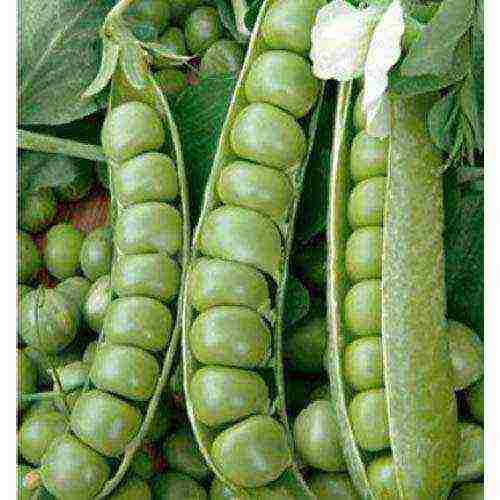
Gloriosa pea variety great for outdoor cultivation
For Ukraine
Peas play an important role in the agriculture of Ukraine. It is grown by both large farms and simple gardeners. More than 50 varieties of this crop are included in the State Register of Breeding Achievements of Ukraine. These include:
- Bosphorus,
- Magnate,
- Cleopatra,
- Zenkovsky,
- Profit,
- Torch,
- Mazepa,
- Gregor,
- Kharkov reference,
- Fargus.
The largest areas are occupied by the planting of modern, highly productive varieties of yellow shell peas, which are intended for the manufacture of cereals. Their striking representative is the German variety Gregor.
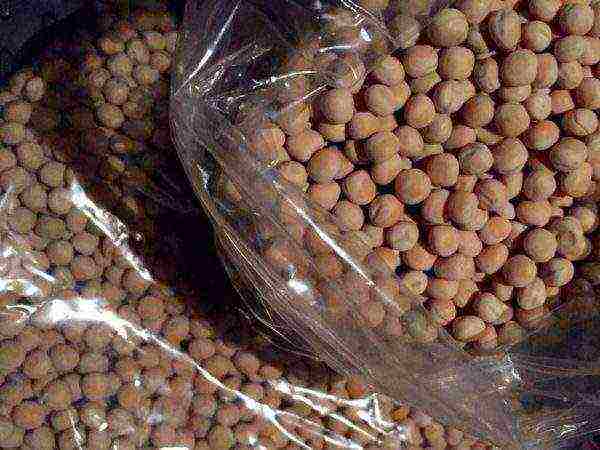
Seeds of yellow hulking peas of the Gregor variety are intended for the manufacture of cereals
It has a high yield (36–52 kg / ha) and is resistant to a lack of moisture. In addition, some of its advantages include:
- fairly high protein content (22–23%);
- a large number of antennae preventing lodging;
- suitability for harvesting by direct combining.
Video: how the Gregor peas grow
For Belarus
Breeders of Belarus pay a lot of attention to the development of new high-yielding pea varieties. Most often, hulling varieties are planted here, which are used for processing into cereals. In addition, this crop is often used as a fodder plant. The State Inspectorate for the Protection and Testing of Breeding Achievements of Belarus recommends 20 varieties of peas to be grown on its territory. These include:
- Stork,
- Ales,
- Belarusian nonshattering,
- Natalievsky,
- Cartoon,
- Chervensky,
- Facet,
- Starter,
- Minsk grain.
Minsk grain is one of the most valuable varieties of this crop in Belarus. It is distinguished by high grain uniformity and high yield of split peas (over 80%). It is a plant with a height of 66–70 cm with beans 6–8 cm long. The peas are large, bluish-green. The average yield of the Minsk grain plant is 33.9 c / ha. It is resistant to lodging and lends itself well to mechanized harvesting.
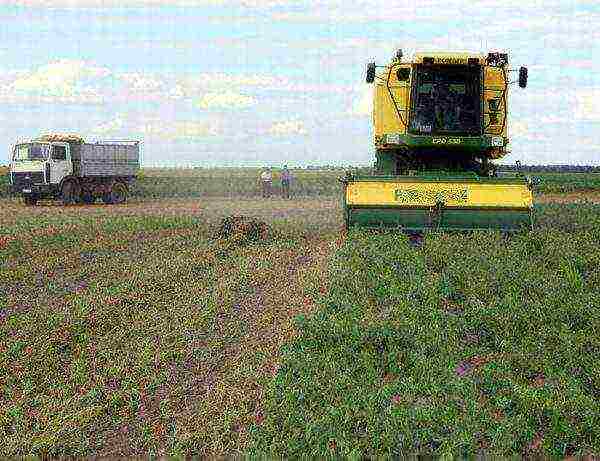
Many agricultural enterprises in Belarus grow peas on an industrial scale
Experienced gardeners advise not to be limited to one varieties when planting peas. A competent selection of crops that differ from each other in use and ripening time will help provide the gardener with tasty and fresh peas throughout the season and make a variety of preparations for the winter.
Since childhood, I have been fond of growing various plants and have achieved considerable success in this matter. I would be very happy to share my experience. Rate the article:
(0 votes, average: 0 out of 5)
